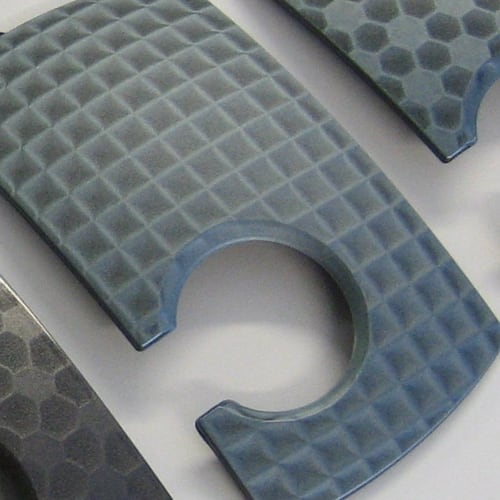The technique results from a partnership between three companies with three different innovations, Mathieu Pivraudan, the CEO of France-based Solev, explained.
Firstly, a plastic capable of holding a residual magnetic charge is supplied by Barlog, this is then moulded to the part required and delivered to Solev which ‘prints’ within the magnetic field the design required, Pivaudran told CosmeticsDesign-Europe.com.
Solev then applies a varnish, provided by Akzo Nobel, that is attracted by this magnetic field and makes the design visible, before a final varnish is added to give depth and resistance.
“The overall effect will be slightly metallicised, but colours can be added by altering the colour of the plastic and colouring the varnish,” Pivaudran explained.
Contrasting colours for a bold effect
Some of the best effects can be achieved using a darkly coloured plastic piece and then adding either a complementary or contrasting varnish, he said.
“A company looking for a discreet 3D effect could use a varnish of the same colour but slightly lighter than the plastic piece, or for a bolder effect a black piece with a red or purple varnish can work really well.”
One of the major advances of the technique, according to Pivaudran, is the liberty that clients have to continue using their existing partners and mould designs.
“Barlog provide the high-tech plastic in pellets that can be formed and moulded using traditional machines by the company’s usual mould partner,” he said.
Although suitable for the majority of plastic components such as perfume bottle caps and make-up cases, an investigation into whether the functional properties of the component are retained with the magnetized plastic needs to be done.
Some parts such as closures for make-up compacts or eye shadows have functional properties that require the plastic to have a memory, Pivaudran explained.

“In some cases we would need to check that the magnetized plastic with the varnish could still perform these functions and then vary the levels of vanish etc if necessary,” he said.
The company claims that the technology is an affordable decorating technique, with the price depending on the level of decoration required.
For a 3D design on only one surface of the product the price will be significantly lower than for a 360 degree design covering the whole product surface, as the latter would require new machinery.
